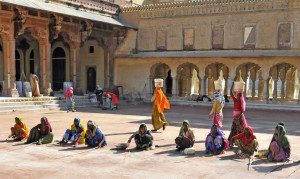Maharaja Man Singh I was a Hindu who became an important general under Akbar, the religiously tolerant Mughal leader. In 1592, Singh began building Amber Fort as a fortified palace on a hill outside Amber, the capital of the area he ruled. The complex was expanded by his grandson, Jai Singh I, and became the largest fort in India.
Today’s visitors can ride an elephant up the road to the entrance of the sandstone and marble fort. The designs inside combine Hindu and Mughal elements. The mosaic-covered Ganesh Pol, a three-story entrance to the living quarters of the Maharaja and his harem, honors Ganesa, the elephant-headed god of new beginnings. The interior walls of the Sheesh Mahal (Mirror Palace) are covered with convex mirrors designed to shimmer in candlelight. An important temple honors Shila Devi, a Hindu goddess.
The floor of the main courtyard of Amber Fort is covered with a mixture of water and cow dung called “gobar.” The flooring must be occasionally replaced, a job usually reserved for women. The women, all colorfully dressed, carry the paste-like gobar on their heads and spread it thinly on the floor. Other women, some with small children in tow, sit in a row behind the freshly applied gobar, tamping it with long paddles until it hardens and they can move forward for the next batch. The task could be done more efficiently with machines, but providing work for India’s citizens may require that such inefficiencies be ignored.
Amber Fort is a UNESCO World Heritage site. A popular backdrop for Bollywood movies, it has become Jaipur’s favorite tourist destination.
